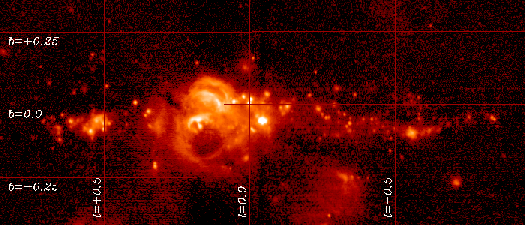Preliminary MSX Galactic Center Results
R.F. Shipman, M.P. Egan & S.D. Price
(Phillips Laboratory, Geophysics Directorate, Hanscom AFB.)

(Click on image to see a slighly larger version.)
The Midcourse Space Experiment (MSX) observatory is a Ballistic Missile
Defense Organization project. SPIRIT III is the primary instrument for
gathering long-wave infrared data during the MSX mission. It consists of
an extremely high off-axis rejection telescope; a five-color, high-spatial
resolution, 4.2 to 26 micron multispectral radiometer; and a six-channel,
high-spectral resolution, 2.5 to 28 micron Fourier transform spectrometer.
The radiometer detectors are arranged in columns to cover 1 degree of
the sky perpendicular to the scan direction.
Two separate Celestial experiments have observed the Galactic Center. From
these, we have over 50 scans across the center from 4 to 26 micron and at
30 times the spatial resolution of IRAS. For a complete description of all
the Celestial experiments see Price (1995) and Price et al. (1996).
The figure shows a 16-26 micron image of one scan across the Galactic
Center. The pixels are 9 arcsec and the image covers roughly 2 x 0.75
degree. The high spatial resolution of SPIRIT III reveals many
details of the Galactic Center that were not seen in earlier
surveys. The image clearly shows the dust emission around Sgr A*
(l=-0.06, b=-0.05) and the dust emission from the thermal radio
filaments (l=+0.2, b=0). Also, for the first time a closed loop is
clearly visible at l=0.2, b=-0.12. Finally, the molecular cloud core,
M0.25+0.01 (Lis et al. 1994), is seen in extinction.
The high spatial resolution of SPIRIT III makes it ideal for studying the
confused regions of our Galaxy. For more images and early results of MSX,
please visit out Web site: 
 GCNEWS
GCNEWS
 GCNEWS
GCNEWS

